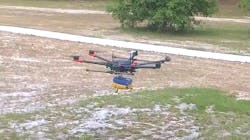Life-Saving Drone Program to Come to FL County
By Emily Wunderlich
Source Sarasota Herald-Tribune, Fla.
Emergency medical services by drone? In Manatee County, that may not be too far-fetched.
On Tuesday, county commissioners approved a contract with the Orlando-based Archer First Response Systems LLC, for the county’s first life-saving drone.
The unmanned, autonomous drone would be dispatched at the discretion of 9-1-1 telecommunicators to deliver an AED, a tourniquet and Narcan to callers while they wait for an ambulance to arrive.
All three of the instruments would be dispatched, regardless of the nature of the emergency. Each of the instruments would come with instructions, and the dispatcher would talk the caller through using them.
Florida Health Sciences Inc., which operates Tampa General Hospital, initially approached the county with the idea and agreed to pay most of the costs associated with the pilot program.
Under the contract with Archer, the county would owe $1 a month for the initial one-year launch.
Records show the county and the hospital system signed a mutual non-disclosure agreement to design and develop the project in June 2019.
In a joint statement on Thursday, the hospital system, the county and Archer said the program would "improve public safety and our ability to respond to the public in an efficient and timely way."
"We achieved an important milestone at Tuesday’s County Commission meeting and we’ll now look to the FAA for an additional round of review and approvals," the statement said.
If the FAA approves the program, the board of county commissioners would ultimately decide whether to move forward with the program.
If it all goes according to plan, Manatee County could be one of the first in the country with such a program, according to public safety director Jake Saur.
“I do believe that this is the future of public safety,” he told county commissioners on Tuesday. “I like that we ride that cutting edge. I think for a county, that's something for us to be proud of. Will it work? Who knows. That’s why it’s a pilot program.”
But being on the cutting edge doesn’t come without its risks. Bill Clague, chief assistant county attorney, warned that the insurance industry hasn’t embraced such emerging technology, so the county would have to rely entirely on its self-insurance fund.
And, he added, there are no court cases to guide the county on potential litigation.
“It’s very difficult for us to quantify for you what the maximum potential exposure is,” he said.
Still, commissioners seemed eager to explore an option that could improve services for residents – especially in unincorporated areas of the county.
The pilot program would be based at the county’s Lakewood Ranch EMS center, 10311 Malachite Drive in Bradenton, and would serve a small portion of Lakewood Ranch within three to four minutes away.
“We’re on the cutting edge of something that could be very, very beneficial to our community,” said Commissioner Reggie Bellamy.
Though Commissioner Stephen Jonsson ultimately voted in favor of the contract, he was wary of the financial risk associated with partnering with what he called a “start-up.”
“We’re going to be on the hook potentially for someone dying because we didn't get the drone there soon enough,” he said.
“I don’t think it’s true that we would be liable anymore than we are today for an ambulance not getting there on time,” said Commission Chair Betsy Benac. “I don’t think this increases our liability because we have another way to deliver services.”
According to its website, Archer First Response Systems was created in 2013 by Gordon Folkes III. A former lifeguard, Folkes was familiar with the need for getting an AED to victims of cardiac arrest before brain damage or death occurred.
His mission was to use small, unmanned aircraft systems to reach victims within five minutes of them calling 911.
The county will lease the FreeFly Systems Alta X model – roughly four feet in diameter with four motors. Using an artificial intelligence-based satellite analysis platform called “Archer Survey,” the drone identifies thousands of optimal delivery coordinates within the coverage area.
Once a 911 dispatcher identifies the caller’s location and the need for the drone, the aircraft can lift off from its ground control hub at the 911 center in less than 18 seconds.
The drone will automatically identify the nearest predetermined coordinate to the caller and arrive in under five minutes, within 50 to 100 feet of the caller.
Without landing, the drone will lower the “medical payload” containing the instruments and return to its hub while 911 operators instruct the caller on how to use them before the ambulance arrives.
Since Manatee County's emergency communications center is accredited by the International Academy of Emergency Dispatch, all medical, fire and law enforcement dispatchers are already trained in how to administer AEDs, Narcan and basic first aid until an ambulance arrives.
And drones are not foreign territory for the county, either. Saur said it already has 11 drones and 36 FAA-licensed pilots that serve a variety of functions, like surveying damages after a natural disaster.
“A lot of stars need to align for this type of pilot program to really get into operation,” Saur said Tuesday.
———
©2020 Sarasota Herald-Tribune, Fla.
Visit Sarasota Herald-Tribune, Fla. at www.heraldtribune.com
Distributed by Tribune Content Agency, LLC.






